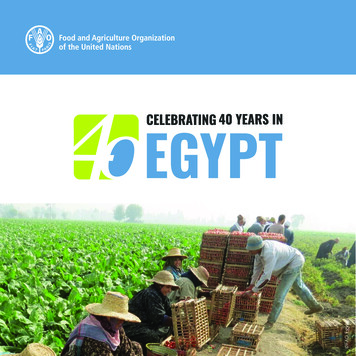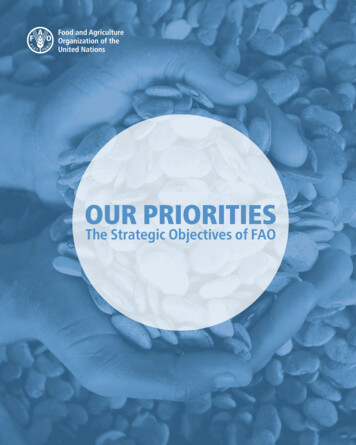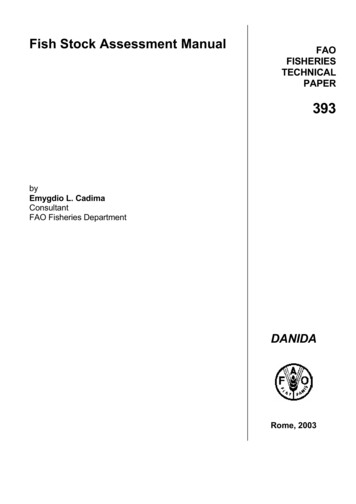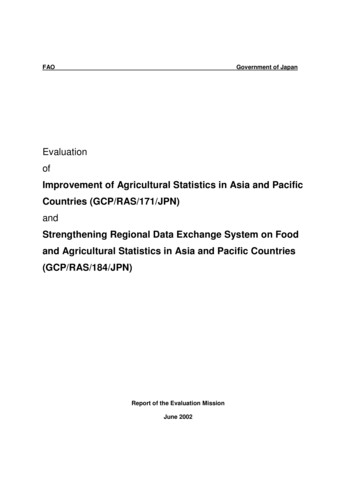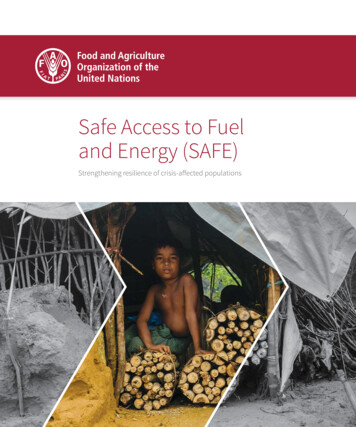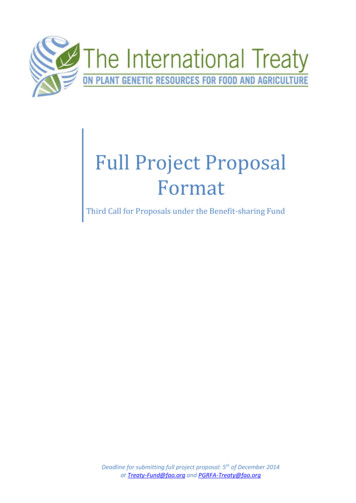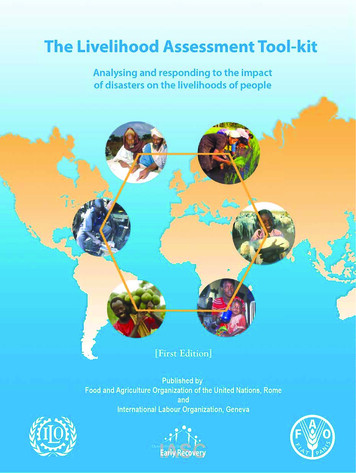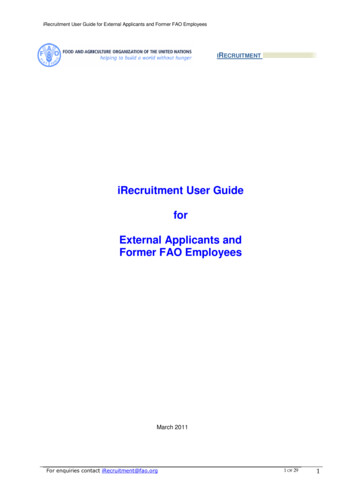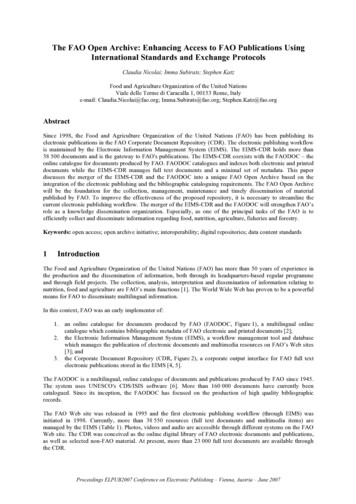
Transcription
The FAO Open Archive: Enhancing Access to FAO Publications UsingInternational Standards and Exchange ProtocolsClaudia Nicolai; Imma Subirats; Stephen KatzFood and Agriculture Organization of the United NationsViale delle Terme di Caracalla 1, 00153 Rome, Italye-mail: Claudia.Nicolai@fao.org; Imma.Subirats@fao.org; Stephen.Katz@fao.orgAbstractSince 1998, the Food and Agriculture Organization of the United Nations (FAO) has been publishing itselectronic publications in the FAO Corporate Document Repository (CDR). The electronic publishing workflowis maintained by the Electronic Information Management System (EIMS). The EIMS-CDR holds more than38 500 documents and is the gateway to FAO's publications. The EIMS-CDR coexists with the FAODOC – theonline catalogue for documents produced by FAO. FAODOC catalogues and indexes both electronic and printeddocuments while the EIMS-CDR manages full text documents and a minimal set of metadata. This paperdiscusses the merger of the EIMS-CDR and the FAODOC into a unique FAO Open Archive based on theintegration of the electronic publishing and the bibliographic cataloguing requirements. The FAO Open Archivewill be the foundation for the collection, management, maintenance and timely dissemination of materialpublished by FAO. To improve the effectiveness of the proposed repository, it is necessary to streamline thecurrent electronic publishing workflow. The merger of the EIMS-CDR and the FAODOC will strengthen FAO’srole as a knowledge dissemination organization. Especially, as one of the principal tasks of the FAO is toefficiently collect and disseminate information regarding food, nutrition, agriculture, fisheries and forestry.Keywords: open access; open archive initiative; interoperability; digital repositories; data content standards1IntroductionThe Food and Agriculture Organization of the United Nations (FAO) has more than 50 years of experience inthe production and the dissemination of information, both through its headquarters-based regular programmeand through field projects. The collection, analysis, interpretation and dissemination of information relating tonutrition, food and agriculture are FAO’s main functions [1]. The World Wide Web has proven to be a powerfulmeans for FAO to disseminate multilingual information.In this context, FAO was an early implementer of:1.2.3.an online catalogue for documents produced by FAO (FAODOC, Figure 1), a multilingual onlinecatalogue which contains bibliographic metadata of FAO electronic and printed documents [2];the Electronic Information Management System (EIMS), a workflow management tool and databasewhich manages the publication of electronic documents and multimedia resources on FAO’s Web sites[3]; andthe Corporate Document Repository (CDR, Figure 2), a corporate output interface for FAO full textelectronic publications stored in the EIMS [4, 5].The FAODOC is a multilingual, online catalogue of documents and publications produced by FAO since 1945.The system uses UNESCO's CDS/ISIS software [6]. More than 160 000 documents have currently beencatalogued. Since its inception, the FAODOC has focused on the production of high quality bibliographicrecords.The FAO Web site was released in 1995 and the first electronic publishing workflow (through EIMS) wasinitiated in 1998. Currently, more than 38 550 resources (full text documents and multimedia items) aremanaged by the EIMS (Table 1). Photos, videos and audio are accessible through different systems on the FAOWeb site. The CDR was conceived as the online digital library of FAO electronic documents and publications,as well as selected non-FAO material. At present, more than 23 000 full text documents are available throughthe CDR.Proceedings ELPUB2007 Conference on Electronic Publishing – Vienna, Austria – June 2007
142Nicolai, Claudia; Subirats, Imma; Katz, StephenResource typefull text documentsphotosvideosaudioTotalNumber of Records23 0008 5006 30075038 550Table 1: Resources at FAO (as at 10 April 2007)For each system described above, the objectives are different. The FAODOC focuses on the cataloguing of FAOdocuments. The EIMS deals with electronic publishing, especially the management at the full text level (ratherthan the description of documents). The CDR focuses on the dissemination of FAO documents archived throughthe EIMS. In 2003, a link between both databases was created, linking the FAODOC records to the full textdocuments archived in EIMS-CDR.Figure 1: FAODOC user interfaceThis paper describes the process of merging the EIMS-CDR and the FAODOC and the creation of the FAOOpen Archive. The result will be one unique sustainable digital repository offering a solid foundation for thecollection, management, maintenance and timely dissemination of material published by FAO. To improve theeffectiveness of the proposed repository, it will be necessary to streamline the existing electronic publishingProceedings ELPUB2007 Conference on Electronic Publishing – Vienna, Austria – June 2007
The FAO Open Archive143workflow and to integrate the current functions into new modules. The FAO Open Archive is based on three keyelements:1.2.3.a metadata set based on international description guidelines and format;a workflow procedure that guarantees the processing of all documents published by FAO; anda system architecture based on cataloguing and electronic publishing.This paper is divided into the following sections: Section 2 presents the current situation for the EIMS-CDR andthe FAODOC; Section 3 details the objectives of the FAO Open Archive; Section 4 describes the workflowprocedures, the new architecture, the compliance to International Standards for Bibliographical Description(ISBD) [7] and metadata sharing with other systems; and Section 5 is the conclusion and the next steps inimplementing the FAO Open Archive.Figure 2: CDR user interface2ObjectivesThe objective of the FAO Open Archive is to create a unique sustainable digital repository for the disseminationof FAO publications and simultaneously, enhance interoperability with other information systems. The FAOOpen Archive will guarantee efficient electronic publishing and metadata management, the effectivedissemination of FAO information resources and the preservation of the Organization’s institutional memory.Proceedings ELPUB2007 Conference on Electronic Publishing – Vienna, Austria – June 2007
144Nicolai, Claudia; Subirats, Imma; Katz, Stephen3Current Situation for EIMS-CDR and FAODOCFAODOC has been managing all bibliographic information for FAO documents and publications for over 30years (since 1976). Since 1998, FAO established a workflow to manage the electronic publishing anddissemination of FAO full text documents through the EIMS-CDR [8]. The EIMS-CDR and the FAODOCworkflows, actors and content are described below.3.1EIMS-CDR, the Electronic Publishing and Digital RepositoryThere are four different user profiles in the EIMS-CDR workflow: originator – the person within the FAO unit responsible for providing the source files and/or the printedcopy of the publication;data owner – the FAO unit responsible for the content of the publication;focal point – the person responsible in EIMS-CDR for managing requests from FAO units [9]; andliaison officer – the person within a FAO unit who ensures that publications are made available online.The liaison officer is the link between the originator and the focal point.Detailed guidelines of the EIMS-CDR workflow are available to all FAO users and EIMS-CDR administrators.Following is a brief description of standard workflow steps:1.2.3.4.5.6.The originator provides source files to the external printing unit. When the publication is printed, theexternal printing unit provides the focal point with the source files, the PDF version and the hard copy.In some cases files are provided by the originator;The data owner creates and locates a record in EIMS;The data owner notifies the focal point of the record and the uploaded files;The focal point completes the record. Conversion to HTML or PDF is handled by focal points oroutsourced to an external company. When conversion is completed, the focal point notifies the dataowner of the test URL for reviewing the publication;The data owner reviews the publication and either approves it or requests changes, by notifying thefocal point;The focal point reviews the final publication, publishes it and notifies the data owner of the publicURL. If no conversion is required, the focal point prepares an HTML table of contents that links to thelow-resolution PDF files and notifies the data owner of the public URL (in some cases only PDF filesare published without the associated HTML pages).Publications are made available in various electronic formats: 3.2Full HTML version; HTML loads quickly and is easier to read on-screen. 14 000 records;Full PDF version; PDF is better for printing and downloading a local copy. 2 200 records;Full HTML version and PDF version. 6 500 records; andHTML table of contents linked to Full PDF version. 500 recordsFAODOC, the Online CatalogueThe FAODOC cataloguing process involves various actors: originator – the person within the FAO unit responsible for delivering to FAODOC the hard copy of thepublications and/or the full text documents to be published in EIMS-CDR;EIMS-CDR focal point – the person who notifies the FAODOC cataloguer of a new record in EIMSCDR, so they link the FAODOC record to the EIMS-CDR full text document; andcataloguer – the person who selects and catalogues the publications (hard copies and full textdocuments from EIMS-CDR).The FAODOC manages the cataloguing of document and the dissemination of bibliographic informationthrough an Online Public Access Catalogue (OPAC). There are procedures for the exchange of informationbetween the FAODOC and the document producers, but there is no specific electronic tool to manage thereception of documents, as exists in the EIMS-CDR workflow. The lack of any workflow management systemmakes it difficult to control the reception and cataloguing of documents.Proceedings ELPUB2007 Conference on Electronic Publishing – Vienna, Austria – June 2007
The FAO Open Archive3.3145Main Differences between EIMS-CDR and FAODOCThe process of merging the two existing databases is a challenging task, as each has a different structure andworkflow procedure. The first step towards the FAO Open Archive was to determine the similarities anddifferences between the EIMS-CDR and the FAODOC.3.3.1Software OverviewThe EIMS-CDR was developed by FAO to manage the electronic publishing workflow. The CDR and the EIMSboth run on a Microsoft Windows platform with an Oracle 9 database server. The software uses Microsoft’sASP programming language (Active Server Pages), with some ad hoc modules and functionalities developed inASP.Net (the successor to ASP). The EIMS architecture results from the interaction of several modules thatmanage different aspects of the overall workflow. All modules interact with a single database that stores therecords’ descriptive metadata and detailed workflow information.The FAODOC uses CDS/ISIS, a software package for information storage and retrieval – developed, maintainedand disseminated by UNESCO. It is freely available for non-commercial purposes. The customization of datainput and output interfaces occurred in Poland at the Institute for Computer and Information Engineering and atFAO.3.3.2Metadata StructureCDS/ISIS manages a database whose main content is text, while the EIMS-CDR uses a relational Oracledatabase. The structure and logic of the two databases are completely different. However, these differences arenot a barrier for the merger into a new single relational database.Both systems use a very similar set of metadata fields to describe documents. The FAODOC contains detaileddocument information, while the EIMS-CDR provides fewer details on the actual document, but stores muchinformation related to the actors, workflow and full text management. The mapping of the EIMS-CDR and theFAODOC databases has already occurred. It was not a complicated procedure, as both systems use a similarmetadata field set. The compliance of both databases to the Dublin Core metadata standard and the AGRIS AP[10] at export level, facilitated the mapping. Only those fields required for the EIMS-CDR workflow have beenadded to those that already exist in the FAODOC.3.3.3Database ContentThe EIMS-CDR and the FAODOC currently use FAO cataloguing guidelines. The decision to adoptinternational cataloguing standards was taken to guarantee interoperability with other digital repositories.75%72%70%64%65%61%60%55%200420052006% of CDR records shared with FAODOCFigure 3: Percentage of the EIMS-CDR records catalogued in the FAODOCProceedings ELPUB2007 Conference on Electronic Publishing – Vienna, Austria – June 2007
146Nicolai, Claudia; Subirats, Imma; Katz, StephenIn the EIMS-CDR, each record corresponds to one document (e.g., a book or a meeting report). The FAODOCcatalogues documents and their analytics (e.g., a document is considered a book and the analytics are itschapters). Therefore, a book can have more than one record. The one-to-many relationship of records will betaken into consideration when merging data from the two databases.The content of the two databases partially overlap, resulting in duplicate bibliographic records. The percentageof the EIMS-CDR full text documents linked from the FAODOC has increased over time (Figure 3): 72 percentof all records created in 2006 in the EIMS-CDR have been linked to from the FAODOC. This implies aduplication of effort (at metadata management level) and jeopardizes the dissemination and the maintenance ofthe FAO’s institutional memory.4The Approach to Create the FAO Open ArchiveThe FAO Open Archive is based on the integration of the electronic publishing and the bibliographiccataloguing requirements. This merger requires the analysis of current workflows to detect similar proceduresand reorganise them into a single coherent workflow. This process should focus on:1.2.3.4.4.1system architecture;workflow procedure;compliance with international data content standards; andexposing metadata in a standardized way.The New System ArchitectureThe architecture of the FAO Open Archive should integrate all features that are currently managed through theEIMS-CDR and the FAODOC. The FAODOC only manages the cataloguing process, but the FAO OpenArchive must include the facility to deal with the reception of documents workflow, and improve thecataloguing module. The electronic publishing system is structured as a modular system where each moduledeals with a specific aspect of document publication. This approach will remain in the new architecture,integrated with new functionalities.Figure 4: FAO Open Archive architectureProceedings ELPUB2007 Conference on Electronic Publishing – Vienna, Austria – June 2007
The FAO Open Archive147The FAO Open Archive architecture is detailed in Figure 4. The following elements define the architecture ofthe system:1.2.3.integrated workflow; from left to right, the flow of information starts from the peripheral input systemelements, passes through the core of the management system and to the dissemination interfaces;common database; andmanagement of the two main functions of the FAO Open Archive; electronic publishing andcataloguing.The objective of the system architecture is to manage all aspects of the electronic document life cycle. Electronicpublishing and cataloguing will be managed through the same system and share the same database, e.g., fromthe document’s creation, to its cataloguing, indexing and conversion to a suitable electronic format, to itsdissemination on the Web.Input for FAO units. This module will be used for data input and will be developed based on the current EIMS.FAO units now have individually customized EIMS interfaces. Each customization involves a basic internalworkflow that can vary from one-step to multiple-step approval. FAO units are responsible for the introduction(and minimal description of documents) into the electronic publishing workflow. In the FAO Open Archive,FAO units will continue to provide data through a user-friendly system describing the document with a minimalset of metadata. With the FAO Open Archive, electronic publishing and cataloguing will share a common dataentry point. The records that the FAO Open Archive will manage includes documents and multimedia files(photos, videos and audio) and non-FAO material (publications written in collaboration with FAO, yet FAOdoes not hold the copyright).Electronic publishing. FAO will continue to publish documents online in electronic format. They will bemanaged through two modules: core module for electronic publishing – this module will be used to review the information from FAO units,based on EIMS, and to manage the conversion of full text documents into electronic formats (HTML, PDF,etc.); and scanning requests managing module – this module will be directly connected to the core module forelectronic publishing and will be used to keep track of the work assigned to internal resources or of the workorders sent for scanning and/or conversion to external companies.Cataloguing. FAO will offshore the cataloguing, using the minimal set of metadata and the full text provided bythe FAO units. FAO cataloguers will check and validate the offshored records in order to guarantee the qualityof the bibliographic description for the full text documents. Cataloguing will also be managed through twomodules: core module for cataloguing – this module will be used to select records to be offshored for cataloguing andindexing and to check metadata quality. It will be used exclusively by cataloguers to manage the informationto be released into the Open Archive; and cataloguing offshoring module – this module will be directly connected to the core module for cataloguingand will be used to manage the XML exports of data to be catalogued by external companies and to manageimport and validation of offshored records.4.2Workflow ProceduresAs well as the architecture, the workflow of the FAO Open Archive must integrate two main activities that so farhave been conducted separately: electronic publishing and cataloguing. Figure 5 shows a top-downrepresentation of the new workflow:1.FAO units initiate a record by inserting a minimal set of metadata into the data input module. Onlyminimal information is requested to initiate a record: author, title, year and job number (a FAO uniqueidentifier). The system verifies whether the job number exists in the database. A simple validationworkflow within the peripheral input system will ensure that the records inserted are eligible forpublication in the FAO Open Archive.Proceedings ELPUB2007 Conference on Electronic Publishing – Vienna, Austria – June 2007
148Nicolai, Claudia; Subirats, Imma; Katz, StephenFigure 5: FAO Open Archive WorkflowProceedings ELPUB2007 Conference on Electronic Publishing – Vienna, Austria – June 2007
The FAO Open Archive2.149The electronic publishing administration and the cataloguing administration are notified of the additionof a new record. They can take action simultaneously on the full text and the metadata of the records.2.1.If the document received is already in electronic format it requires validation and conversionto the most suitable format. This task can be carried out in-house or can be offshored. If thedocument needs digitalization then it is offshored for scanning.2.2. Using the minimal set of metadata in the system and the link to the full texts, the documentsare catalogued and indexed by FAO and/or external cataloguers. The records that are selectedfor offshoring are exported using XML. When exported records are received from the externalcompany they are imported into the system, checked and validated.3. Validated records are disseminated through FAO Web sites. Moreover, search engines, services providersand digital libraries will harvest the records’ metadata enhancing access to FAO documents.4.3Compliance with International Data Content Standards, ISBDDuring the past few years, ISBD [11] has been identified as the standard most suitable for FAO. In April 2006, astudy of the impact of changing FAO cataloguing rules recommended the adoption of ISBD rules:“. recommend that FAO adopt the ISBD rules and build a system that will send and acceptqueries according to the OpenURL standard. In this way, FAO will build a system that willwork with (interoperate with) other catalogues, while making FAO documents far moreaccessible to users. FAO, OCLC and other databases can create OpenURLs based on recordsthat follow international guidelines and in this way, create an interoperable system [12]”.ISBD rules are rigorous and exact. ISBD is based on the principles of adequate identification, searchability andconsistency so that:1.2.no two different documents can be confused with each other; andthe many details comprising a description, are presented in a uniform manner so that they can beinterpreted without unnecessary ambiguity [13].By applying the ISBD rules, FAO will not only enhance the international exchange of FAO records, but willalso assist in the interpretation of records across languages, because ISBD records can be interpreted on a firstlevel (identification of elements) by users of every language. This is because of the fixed order of ISBD records.Finally, ISBD is independent of any metadata format. In conclusion, ISBD rules are simple, exact, widely usedand supported by the International Federation of Library Associations and Institutes (IFLA). ISBD will facilitatethe interoperability with other institutions and/or services providers, as it is an international standard followed bymany of the world’s major libraries and bibliographic institutions.One of the biggest challenges will be the handling of the legacy data; old records require re-cataloguing, e.g.,titles need to be transcribed according to ISBD rules. A possible solution could be to import bibliographicrecords from databases that have already catalogued FAO documents, ignoring fields that are not relevant toFAO’s needs and adding specific information already existing in FAO records, e.g., AGROVOC Thesaurus [14]descriptors. However, the legacy data can be updated, prioritizing those records which have the full textavailable and/or are accessed on a regular basis. The introduction of an additional code to distinguish old fromnew ISBD records is required.The FAO units will introduce a minimal-level description based on ISBD and the offshored and FAOcataloguers could then bring the records to full ISBD level.4.4Exposing Metadata in a Standardised WayThis is a very important issue, and it has been addressed successfully by the Open Archives Initiative (OAI).Open Archive Initiative Protocol for Metadata Harvesting (OAI-PMH) is a simple protocol that allows dataproviders to expose their metadata for harvesting to services providers. The FAO Open Archive will be OAIcompliant, so the FAO metadata can be harvested by any services providers and/or digital libraries.The concept of OAI-PMH can be applied to a wide range of digital materials, e.g. images, audio or videos. It ismandatory to expose metadata as Dublin Core. It is important to note that the protocol enables multiple metadataProceedings ELPUB2007 Conference on Electronic Publishing – Vienna, Austria – June 2007
150Nicolai, Claudia; Subirats, Imma; Katz, Stephenformats. These alternative forms of metadata can be as rich as is necessary to describe content. During the lastfew years, FAO has made an intensive effort to promote the exchange of high-quality metadata within theAGRIS Network, an international initiative based on a collaborative network of institutions in agriculture andrelated subjects. The AGRIS AP is a metadata format that facilitates sharing of metadata across differentinformation systems. It is a metadata schema which uses elements from metadata standards such as Dublin Core(DC), Australian Government Locator Service Metadata (AGLS) [15] and Agricultural Metadata Element Set(AgMES) [16] namespaces. The standard enhances the quality of the description of agricultural informationresources, enabling greater processing possibilities by service providers. The AGRIS AP has proved to be asuccessful initiative, and as a result, the FAO Open Archive will be fully compliant with the AGRIS AP atexport level.In conclusion, exposing metadata will:1.2.3.5improve the retrieval of FAO documents from a large number of sources (e.g., portals, aggregators andservices providers);allow aggregators to detect FAO documents and thereby help to disseminate them; andenhance the visibility and awareness of FAO’s available resources.Conclusions and Next StepsThis paper illustrates the first phase for the creation of the FAO Open Archive, focussing on finding a strategy tosolve:1.2.the duplication of efforts in creating and managing metadata; andthe lack of integration of electronic publishing and cataloguing.The relevant findings from this first phase are: The FAODOC and the EIMS-CDR will use a common database and a workflow supported by aworkflow management system. FAO will supply FAO bibliographic metadata together with the fulltext.The conversion of the FAODOC and the EIMS-CDR to the FAO Open Archive will facilitate the datainput and maintenance of information. The FAO units will continue to be involved in the metadatacreation process.The use of ISBD rules will simplify the creation of metadata. The legacy data will be updated to ISBDstandards, prioritizing those records, which a) are accessed on a regular basis, and b) have the full textavailable to improve the effectiveness of the OpenURL protocol.The visibility and dissemination of FAO documents will be maximized by exposing content throughOAI-PMH. The FAO Open Archive should have the ability to transfer and use information in a uniformand efficient manner across multiple organisations and information technology systems.The creation of the FAO Open Archive will strengthen FAO’s role as a knowledge dissemination organization.The following phase is related to the software implementation. The integration of open source software intoFAO Open archive is still under evaluation.AcknowledgementsWe would like to thank Anne Aubert, Johannes Keizer, Giorgio Lanzarone, Romolo Tassone and JimWeinheimer for their valuable contributions.Notes and References[1][2]FAO Constitution, Article I. http://www.fao.org/docrep/x1800e/x1800e01.htm#1 Last accessed in April2007.Catalogue for Documents produced by FAO (FAODOC) http://www4.fao.org/faobib/index.html Lastaccessed in April 2007.Proceedings ELPUB2007 Conference on Electronic Publishing – Vienna, Austria – June 2007
The FAO Open 5][16]151Electronic Information Management Services (EIMS). http://www.fao.org/eims/ Last accessed in April2007.Corporate Document Repository (CDR) http://www.fao.org/documents/ Last accessed in April 2007.The Knowledge Exchange & Capacity Building Division (KCE) of FAO is the responsible for all theabove mentioned systems.AGRIS/CARIS Centre of Information Management for international agricultural researchhttp://www.fao.org/Agris/ Last accessed in April 2007.International Standards for Bibliographic Description (ISBDs http://www.ifla.org/VI/3/nd1/isbdlist.htmLast accessed in April 2007.SALOKHE, G.; PASTORE, A.; RICHARDS, B.; WEATHERLEY, S.; AUBERT, A.; KEIZER, J.;NADEAU, A.; KATZ, S.; RUDGARD, S.; MANGSTL; ANTON. FAO’s role in InformationManagement and Dissemination – Challenges, Innovation, Success, Lessons Learned. e00.pdf Last accessed in April 2007.This task involves the scanning and conversion of documents, corrections, modifications and thepublication of HTML/PDF files.The AGRIS Application Profile for the International Information System on Agricultural Sciences andTechnology Guidelines on Best Practices for Information Object 909e00.htm Last accessed in April 2007.In 1969 the International Federation of Library Associations and Institutes (IFLA) created a generalframework for the creation of standards to regularize the form and content of bibliographic descriptions(Byrum, J.D., "The Birth and Re-birth of the ISBDs: Process and Procedures for Creating and Revisingthe International Standard BibIiographic Descriptions". IFLA journal, Vol. 27, No. 1, 2001). The workresulted in the ISBD rules which specify the requirements for the description and identification of themost common types of resources that are likely to appear in library collections.WEINHEIMER, J. (2006). Consequences of changing FAO cataloguing rules & format withISBD/AACR2/MARC21: a report for the Food and Agriculture Organization of the United Nations.Internal report.COETZEE, H. (2005). Do we still need bibliographic standards in computer systems?http://www.liasa.org.za/interest groups/igbis/papers/IGBIS WSJul04 Bib Stds Helena Coetzee.docLast accessed in April 2007.AGROVOC is a multilingual structured and controlled vocabulary designed to cover the terminology ofall subject fields in agriculture, forestry, fisheries, food and related domains.http://www.fao.org/aims/ag intro.htmAGLS Metadata Standard http://www.naa.gov.au/recordkeeping/gov online/agls/summary.html Lastaccessed in April 2007.Agricultural Metadata Element Set (AgMES) http://www.fao.org/aims/intro meta.jsp Last accessed inApril 2007.Proceedings ELPUB2007 Conference on Electronic Publishing – Vienna, Austria – June 2007
3. the Corporate Document Repository (CDR, Figure 2), a corporate output interface for FAO full text electronic publications stored in the EIMS [4, 5]. The FAODOC is a multilingual, online catalogue of documents and publications produced by FAO since 1945. The system uses UNESCO's CDS/ISIS software [6]. More than 160 000 documents have .


